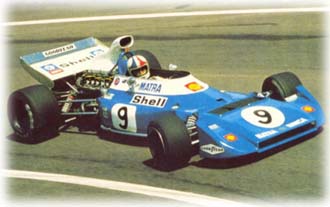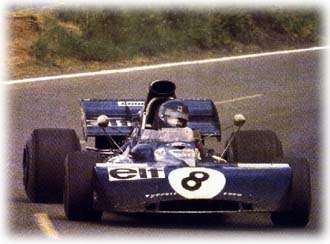| ATLAS F1 Volume 6, Issue 26 | |||
 |
A Race to Remember | ||
| by Marcel Schot, Netherlands | |||
|
Every Grand Prix Venue has its most remembered race; that race where the mighty gods of Formula One diced and dodged to achieve eternal greatness and set the record books straight. But every Grand Prix venue also has remarkable races that were pushed aside in the history books, for no good reason. Atlas F1 writer Marcel Schot reviews, ahead of every Grand Prix this season, one race which should be memorised and valued; that one round in history which makes a Race to Remember
The French Grand Prix is one of those races that have become part of the texture of Formula One. Only in 1955 the circus passed France without a visit, after the French withdrew because of the horrible accident at Le Mans that cost 55 lives.
Nonetheless, it was Clermond-Ferrand that hosted one of the most special Grands Prix in France ever, starring a driver who rarely made it to the spotlight. Even though Jackie Stewart won the race, Chris Amon was the man of the weekend. The man from New Zealand never made it to the top step of the podium, but he is widely acknowledged as one of Grand Prix Racing's hidden talents. In the French Grand Prix of 1972 he showed the world what he was all about: in a brand new Matra chassis, Amon gave the competition a tough run for their money.
Before the race
Emerson Fittipaldi came to France with a comfortable lead in the championship. Partly due to Jackie Stewart's absence at Nivelles, one race earlier - the Scot had a stomach problem keeping him from racing, the Brazilian Lotus driver had a nine-point lead over McLaren driver Denny Hulme, with Belgian Ferrari pilot Jacky Ickx three points behind him. Stewart followed another four points behind Ickx, driving the Tyrrell.
Stewart's medical problems were sufficiently solved to race in France, but now another regular driver was missing. Ferrari driver Clay Regazzoni was the unfortunate one this time. The Swiss driver had broken his wrist while playing soccer in Austria. Ferrari, now without a second driver, asked Italian Nanni Galli to take over Regazzoni's car. Galli's place at the Tecno team was taken over by Derek Bell.
In second practice, most drivers were more familiar with the track, showing much improvement in the times. Stewart took eight tenths off his previous best. However, Matra's Chris Amon showed more and took a full two seconds off his time to end up three tenths faster than Stewart. Stewart's teammate Francois Cevert put things straight after the first session, setting the fifth fastest time in the second session.
In the third and final session, it became clear that Amon was in a class of his own. While Hulme came back from a bad second session with a 2:54.2, half a second faster than Amon's provisional pole after two sessions, Amon crushed the opposition with a 2:53.4. On the second row Stewart and Ickx were over one and a half second behind Amon. The third row was a complete surprise. Tim Schenken in the Surtees had a great third session, taking almost 2.5 seconds off his fastest until then. Next to him was the Austrian talent Helmut Marko, driving for BRM. This surprise put championship leader Emerson Fittipaldi back to the fourth row, alongside Cevert.
The race
When the race started, the 25 cars got away in qualifying order to start the first of their 38 laps. Chris Amon was closely followed by Denny Hulme and Jackie Stewart, while the others already were left behind a little. By lap four, the first car fell victim to the fifty corner circuit. Austrian Niki Lauda, in his first full season at March, was forced aside with a broken driveshaft. Meanwhile, Amon slowly started building a lead over Hulme and Stewart.
When Hulme was passed by Stewart it quickly became clear that this would be a two horse race. Amon pulled away from Stewart and Stewart pulled away from the rest of the field. After eight laps, the track took its second victim, this time in a much worse way than Lauda's mechanical problem earlier. As the track, most of which was laid out on mountainous volcanic rock landscape, was badly prepared for the race, the sides if the asphalt were covered with small rocks and debris. When the talented young Austrian Helmut Marko steered his car slightly over the edge of the track in one of its corners, his wheel caught a rock and catapulted it into the air. Unfortunately, the rock hit Marko's visor, piercing it with its sharp point and injuring the driver's eye. The accident rendered Marko blinded in one eye, ending his promising racing career. Marko had been widely acknowledged as a big talent, which showed in his good qualifying position and a win at Le Mans in 1971.
However, one lap after Pace's exit, things changed dramatically. Amon, most definatelly one of the unluckiest drivers in Formula One history, caught one of the now notorious rocks on the side of the track. In one way he was lucky to escape Marko's fate, but the tyre was punctured, making a pitstop necessary. Thankfully, Amon's misfortune happened just as he drove uphill towards the pitstraight, so the New Zealander was home quickly. However, there's were his luck ended. When his crew wanted to pull of the damaged wheel, it jammed, thus delaying the stoppage time. After standing in the pitbox for nearly a full minute, Amon rejoined the race ninth. The leaders were well out of reach, with Jackie Stewart now in a comfortable first place with nothing to worry about. This allowed him to ease off a little and concentrate on avoiding the rocks, rather than having to drive all out to catch up with Amon.
Amon, angry because he saw yet another potential victory go up in flames, was now unleashed. The Matra driver drove like a man possessed, aided by his car's decreasing fuel load, which made the car more drivable as it got lighter. On a circuit that consisted of only corners and without long straights, Amon still managed to pass car after car. With three laps to go, Amon was in sixth place and close behind the dueling duo of Cevert and Peterson. This was a miracle already, as those two were some 35 seconds ahead of Mike Hailwood, who was behind Amon. Nevertheless, Amon's hunger wasn't satisfied and in a truly miraculous lap the New Zealander overtook both Peterson and Cevert. Now on his way to the second placed Emerson Fittipaldi, Amon drove the twisty track as if no danger existed. With a gap of nearly twenty seconds, the Brazilian seemed impossible to catch, but Amon didn't rest in third place. He drove no less than four seconds per lap faster than the championship leader, leaving Fittipaldi a little unsure of his position after all.
Conclusion
This race showed that it's very well possible for a single man to make a race memorable. While Jackie Stewart demonstrated he was the master of Clermond-Ferrand, Amon scored Formula One's most famous non-victory. Without Amon this race would have been just another race, mostly remembered for Helmut Marko's terrible accident, but Amon showed what true power of will can bring a man. If ever a racer was awarded too few points for his performance it was this one.
For the championship, the outcome of the race didn't make things any more exciting. Jackie Stewart closed in on Fittipaldi, but in the end Fittipaldi's initial lead appeared too large to overcome with one race less to score in.
|
| Marcel Schot | © 2000 Kaizar.Com, Incorporated. |
| Send comments to: schot@atlasf1.com | Terms & Conditions |




